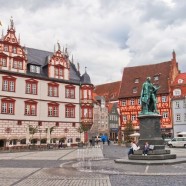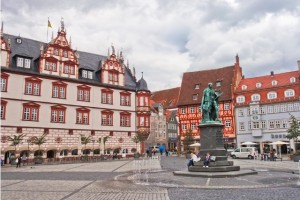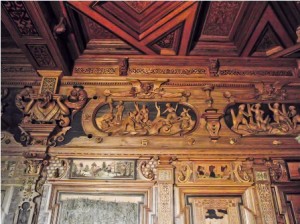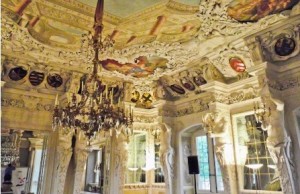The Castles and Charm of Coburg
Bavaria’s Coburg is rich in royal history, unique attractions and much more.
At first glance, Coburg appears to be a typical charming German town with attractive castles and landmarks neatly snuggled along Bavaria’s Castle Road and Toy Road routes. With a little research and planning, however, you can craft an itinerary for your clients that will allow them to experience a lesser-known Coburg.
They can walk in the halls of history and learn about a family that spread its wings and influence across Europe and the world. The duchy of Coburg can trace its roots back a millennium. The first documented reference to the name, “Coburg,” was found as early as the 11th century and, today, Coburg makes up part of the state of Saxe-Coburg-Gotha.
The number of royals that can trace their heritage to Coburg is staggering. For nearly two centuries, members and descendents of the House of Saxe-Coburg-Gotha have married their way into nearly every royal family of prominence. The current or last ruling monarchs of Great Britain, Norway, Denmark, Belgium, Russia, Prussia, Spain, Romania, Greece, Portugal and Italy — as well as Mexico — all have direct blood ties to the Coburg line and the Saxe-Coburg-Gotha house. The breadth and depth of this duchy’s reach today is such that it spans more than a dozen major European countries, with direct male descendents, and many other descendents across all continents.
Attractions in the Heart of Coburg
Several of the sites in and around Coburg bring to life the history of the house and its royals. The city’s iconic landmark and major attraction is the Veste Coburg castle. As one of the best-preserved castles and fortresses in Germany, the Veste Coburg served as a residence of the head of the house of Saxe-Coburg-Gotha until his death in 1998. Now open to the public, the castle is Coburg’s prime attraction and with good reason (the Veste Coburg houses the duchy’s art collection of antique glass and historical weapons). Tell your clients to take time to browse the wooden-engraved hunting room — its unique and intricate detailing is unrivaled.
Coburg’s second-most central palace, Ehrenburg Castle, with its distinct neo-gothic facade, was rebuilt from the ashes of its original structure, a castle and monastery dating back to the Middle Ages. England’s Queen Victoria resided at Ehrenburg during her frequent visits with Prince Albert. The castle features courtyards and gardens and is within easy walking distance of Schlossplatz and Markt squares. For larger group functions or special itineraries, the castle offers the palatial Riesensaal or Hall of Giants. The Schlosskirche, or Palace Church, is also available for concerts, recitals and weddings.
Another landmark building on the main square is the Hofapotheke or Court Pharmacy. One of Coburg’s oldest surviving private houses, the building was built in the mid 13th century and has been a pharmacy since 1543. Here, clients can see traditional turn-of-the-century medicine and purchase unique liqueurs and tonics used to cure illnesses. The Hofapotheke is only open for visits by prior appointment, so make sure to call ahead of time.
Every visit to Coburg should include a sampling of its famous Coburger bratwurst. This delicacy is a foot-long sausage of pork and beef, served on a tiny bun that only covers the middle of the sausage. To say that you have eaten a Coburger in Coburg is a claim not many can make, so make sure that your clients try one for a snack or a quick lunch.
Coburg’s Countryside
Outside of Coburg, Callenberg Castle acted as the summer home and palace of many a duke. The castle is open to the public, and guided tours are available. For a slice of British royal history, clients should visit Rosenau Castle, the neo-gothic, English-style castle and its adjoining park. It’s here that Prince Albert, who would later wed Queen Victoria, was born. Queen Victoria called Rosenau her “real home,” and it was a favored residence. Other castles in the area include Hohenfels Castle and Niederfullbach Castle, both of which are privately owned and are not open to visitors.
A visit to Coburg is like a walk through the romantic history of a town that has inspired Hollywood to create several movies, most recently “The Young Victoria” in 2009. Coburg seems to be a fantasy town of castles where royal crowns abound, and it is a fantastic destination for any client interested in history, architecture, art and royal life. Even clients who are not typically interested in history will appreciate the centuries of influence it had in shaping our world today.
The Details
Coburg Tourism
www.coburg-tourist.de
German National Tourist Office
www.germany.travel
Travel Insider
Marc Kassouf is owner and CEO of Pride Travel, which specializes in catering to the needs of gay and lesbian clientele. Kassouf holds numerous industry certifications, most notably by Cruise Lines International Association, the Travel Institute and various destination visitors’ bureaus including Europe, Asia and the Americas. He sits on two board committees of the International Gay and Lesbian Travel Association and has traveled to nearly four dozen countries and sailed on more than 60 cruises.
888-748-9876
www.pride.travel
First published: TravelAge West magazine, May 23, 2011











 Editor Marc Kassouf owns Pride Travel agency. He holds numerous travel industry certifications and has received one of the travel industry’s most prestigious awards, the WAVE TrendSetter, four times; the TrendSetter recognizes excellence and exceptional achievements of travel agencies and their executives. Kassouf sat on two board committees of the International Gay and Lesbian Travel Association, has traveled to nearly four dozen countries and has sailed on more than 60 cruises.
Editor Marc Kassouf owns Pride Travel agency. He holds numerous travel industry certifications and has received one of the travel industry’s most prestigious awards, the WAVE TrendSetter, four times; the TrendSetter recognizes excellence and exceptional achievements of travel agencies and their executives. Kassouf sat on two board committees of the International Gay and Lesbian Travel Association, has traveled to nearly four dozen countries and has sailed on more than 60 cruises.







